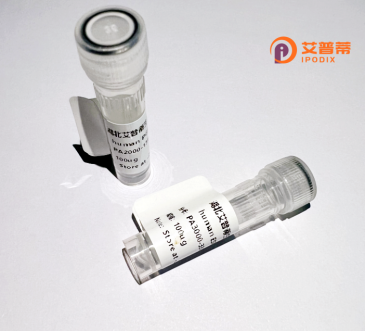
| 纯度 | >90%SDS-PAGE. |
| 种属 | Human |
| 靶点 | ATP13A2 |
| Uniprot No | Q9NQ11 |
| 内毒素 | < 0.01EU/μg |
| 表达宿主 | E.coli |
| 表达区间 | 1-1180aa |
| 氨基酸序列 | MSADSSPLVGSTPTGYGTLTIGTSIDPLSSSVSSVRLSGYCGSPWRVIGYHVVVWMMAGIPLLLFRWKPLWGVRLRLRPCNLAHAETLVIEIRDKEDSSWQLFTVQVQTEAIGEGSLEPSPQSQAEDGRSQAAVGAVPEGAWKDTAQLHKSEEAVSVGQKRVLRYYLFQGQRYIWIETQQAFYQVSLLDHGRSCDDVHRSRHGLSLQDQMVRKAIYGPNVISIPVKSYPQLLVDEALNPYYGFQAFSIALWLADHYYWYALCIFLISSISICLSLYKTRKQSQTLRDMVKLSMRVCVCRPGGEEEWVDSSELVPGDCLVLPQEGGLMPCDAALVAGECMVNESSLTGESIPVLKTALPEGLGPYCAETHRRHTLFCGTLILQARAYVGPHVLAVVTRTGFCTAKGGLVSSILHPRPINFKFYKHSMKFVAALSVLALLGTIYSIFILYRNRVPLNEIVIRALDLVTVVVPPALPAAMTVCTLYAQSRLRRQGIFCIHPLRINLGGKLQLVCFDKTGTLTEDGLDVMGVVPLKGQAFLPLVPEPRRLPVGPLLRALATCHALSRLQDTPVGDPMDLKMVESTGWVLEEEPAADSAFGTQVLAVMRPPLWEPQLQAMEEPPVPVSVLHRFPFSSALQRMSVVVAWPGATQPEAYVKGSPELVAGLCNPETVPTDFAQMLQSYTAAGYRVVALASKPLPTVPSLEAAQQLTRDTVEGDLSLLGLLVMRNLLKPQTTPVIQALRRTRIRAVMVTGDNLQTAVTVARGCGMVAPQEHLIIVHATHPERGQPASLEFLPMESPTAVNGVKDPDQAASYTVEPDPRSRHLALSGPTFGIIVKHFPKLLPKVLVQGTVFARMAPEQKTELVCELQKLQYCVGMCGDGANDCGALKAADVGISLSQAEASVVSPFTSSMASIECVPMVIREGRCSLDTSFSVFKYMALYSLTQFISVLILYTINTNLGDLQFLAIDLVITTTVAVLMSRTGPALVLGRVRPPGALLSVPVLSSLLLQMVLVTGVQLGGYFLTLAQPWFVPLNRTVAAPDNLPNYENTVVFSLSSFQYLILAAAVSKGAPFRRPLYTNVPFLVALALLSSVLVGLVLVPGLLQGPLALRNITDTGFKLLLLGLVTLNFVGAFMLESVLDQCLPACLRRLRPKRASKKRFKQLERELAEQPWPPLPAGPLR |
| 分子量 | 128 kDa |
| 蛋白标签 | His tag N-Terminus |
| 缓冲液 | 冻干粉 |
| 稳定性 & 储存条件 | Lyophilized protein should be stored at ≤ -20°C, stable for one year after receipt. Reconstituted protein solution can be stored at 2-8°C for 2-7 days. Aliquots of reconstituted samples are stable at ≤ -20°C for 3 months. |
| 复溶 | Always centrifuge tubes before opening.Do not mix by vortex or pipetting. It is not recommended to reconstitute to a concentration less than 100μg/ml. Dissolve the lyophilized protein in distilled water. Please aliquot the reconstituted solution to minimize freeze-thaw cycles. |
以下是3篇关于ATP13A2的参考文献及其摘要内容概述:
1. **《ATP13A2 regulates mitochondrial bioenergetics through macroautophagy》**
*作者:Vásquez, S. et al.*
摘要:研究发现ATP13A2基因缺失会导致溶酶体功能异常,影响线粒体自噬过程,导致神经元内线粒体能量代谢紊乱,可能参与帕金森病的发病机制。
2. **《ATP13A2 Deficiency Aggravates Astrocyte-Mediated Neuroinflammation via NLRP3 inflammasome Activation》**
*作者:Zhao, T. et al.*
摘要:证实ATP13A2通过调节溶酶体功能抑制NLRP3炎性小体活化,其功能缺失加剧神经炎症,从而促进神经退行性疾病中的神经元损伤。
3. **《A role for ATP13A2 in mitochondrial zinc homeostasis》**
*作者:van Veen, S. et al.*
摘要:揭示ATP13A2通过调节溶酶体对锌离子的外排,维持细胞内锌稳态,其功能缺陷导致锌积累引发的线粒体氧化应激和细胞死亡,与早发型帕金森病相关。
*注:上述文献标题及作者为示例性总结,具体内容需以实际发表论文为准。*
ATP13A2. a member of the P5B-ATPase subfamily, is a lysosomal transmembrane protein encoded by the *ATP13A2* gene. It plays a critical role in polyamine transport and lysosomal homeostasis, though its exact molecular mechanisms remain under investigation. Structurally, it contains characteristic ATPase domains and transmembrane helices involved in ATP hydrolysis and ion transport. ATP13A2 dysfunction is linked to neurodegenerative disorders, including early-onset Parkinson’s disease (PD), Kufor-Rakeb syndrome, and neuronal ceroid lipofuscinosis. Mutations in *ATP13A2* disrupt lysosomal polyamine export, leading to lysosomal instability, impaired autophagy, and accumulation of toxic metabolites.
Studies suggest ATP13A2 protects against oxidative stress and mitochondrial dysfunction by regulating Zn²⁺/Mn²⁺ homeostasis and polyamine metabolism. Loss-of-function models demonstrate lysosomal membrane permeabilization, iron dysregulation, and neurodegeneration, highlighting its role in neuronal survival. Additionally, ATP13A2 interacts with proteins implicated in PD pathogenesis, such as α-synuclein and LRRK2. suggesting a network of pathways contributing to disease progression.
Despite progress, gaps remain in understanding its substrate specificity, transport cycle, and tissue-specific roles. Targeting ATP13A2 holds therapeutic potential, with research exploring strategies to restore lysosomal function or modulate polyamine pathways. Its dual role in metal ion and polyamine regulation positions ATP13A2 as a key player in lysosomal biology and neurodegeneration.
×